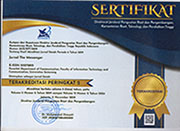Effects of Communication and Characteristics in Pekka Groups on the Economic Empowerment of Members
Abstract
The study was conducted in Batang Regency, Central Java. Still high levels of family poverty in this area, especially the condition of the family head women and tend to have non-permanent work, make the authors interested in doing this in-property research. Research methods using quantitative mixed methods are strengthened by qualitative analysis. The sampling technique uses stratified random sampling, using the Slovin formula to determine the magnitude of the number of respondents. The study population numbered 535, with a total sample of research were 229 female heads of households. The results showed that indicators of group roles and companion roles had a very large contribution in encouraging the characteristics of women's household heads to be more empowered. Through a companion role, making a family of female heads more actively communicating. Through the development of public speaking, establishing a critical culture in the group, thus growing self-confidence, forming a empowered, independent, and potential self. Important research is conducted to see the extent to which the women's head program has walked the trunk, creating many tough women. Research novelty was obtained based on a combination of group communication attributed to economic empowerment.
Keywords
Full Text:
PDFReferences
Aboo, K., & Khalid, T. (2014). Women and politics: Social construction and deconstruction. Research Gate Journal, 10(3), 104 113. https://doi.org/10.3844/jsssp.2014.104.113
Alm ¥s, I., Armand, A., Attanasio, O., & Carneiro, P. (2018). Measuring and Changing Control: Women s Empowerment and Targeted Transfers. Economic Journal, 128(612), F609 F639. https://doi.org/10.1111/ecoj.12517
Antunovic, D., & Hardin, M. (2013). Women bloggers: identity and the conceptualization of sports. SAGE Journal, 15(8), 1374 1392. https://doi.org/https://doi.org/10.1177/1461444812472323
Asni. (2018). Perempuan kepala keluarga dan pencari nafkah di pasar Baruga Kabupaten Kendari dalam perspektif hukum Islam. Jurnal Hasil-Hasil Penelitian, 12(1), 67 84. https://doi.org/http://dx.doi.org/10.31332/ai.v12i2.641.
Baer H. (2016). Redoing feminism: digital activism, body politics, and neoliberalism. Research Gate Journal, 16(1), 17 34. https://doi.org/https://doi.org/10.1080/14680777.2015.1093070
[Bappenas] Badan perencanaan dan pembangunan nasional. (2013). Pembangunan Kesetaraan Gender Background Study RPJMN III (2015-2019). Bappenas Pers.
Budhirianto, S. (2015). Pola Komunikasi untuk Pemberdayaan Kelompok Informasi Masyarakat dalam Menyukseskan Program Swasembada Pangan. Jurnal Pekommas, 18(2), 127 138. https://doi.org/10.30818/jpkm.2015.1180206
Curtis, Floyd, James, Winsor, & Jerry. (2005). Komunikasi Bisnis dan Profesional (8th ed.). PT Remaja Rosdakarya.
Friedman, J. (1994). Empowerment The Politics of Alternative Development (1st ed.). Blackwell Publishers.
Fukui, Nakamura, & Steinsson, J. (2019). Women, Wealth Effects, and Slow Recoveries. National Bureau of Economic Research Working Paper, 23(3), 25 31.
Ganesh, S., & Zoller, H. (2012). Dialogue, activism, and democratic social change. The Commun Journal, 21(1), 66 91. https://doi.org/https://doi.org/10.1111/j.1468-2885.2011.01396.x
Ginandjar. (1996). Pembangunan untuk rakyat: memadukan pertumbuhan dan pemerataan. (1st ed.). PT Pustaka Cidesindo.
Ginting. (2009). Hubungan antara kemampuan komunikasi kelompokdengan peningkatan partisipasi masyarakat dan efektivitas pelaksanaan program IDT. Pekommas, 18(2), 128 137.
Hasinoff. (2014). Contradictions of participation: critical feminist interventions in new media studies. Communication and Critical/Cultural Studies Journal, 11(3), 270 272. https://doi.org/https://doi.org/10.1080/14791420.2014.9 26242
Hubeis, A. (2010). Pemberdayaan Perempuan dari Masa ke Masa (1st ed.). IPB Press.
Humphries, J., & Saras ºa, C. (2012). Off the Record: Reconstructing Women s Labor Force Participation in the European Past. Feminist Economics Journal, 18(4), 39 67. https://doi.org/https://doi.org/10.1080/13545701.2012.746465
Indardi. (2016). Pengembangan Model Komunikasi dalam Pemberdayaan Masyarakat Tani (Studi Kasus pada Kelompok Tani Jamur Merang Lestari Makmur di Desa Argorejo, Sedayu, Bantul). Journal of Agribusiness and Rural Development Research, 2(1), 75 86. https://doi.org/10.18196/agr.2128
Jamaris. (2016). Kompetensi Pendamping Pembangunan Desa. 1 36. https://www.researchgate.net/publication/324221842_KOMPETENSI_PENDAMPING_PEMBANGUNAN_DESA_PROSIDING_SEMINAR_NASIONAL
Kabeer, N. (2010). Women s empowerment, development interventions and the management of information flows. IDS Bull Journal, 41(6), 105 113. https://doi.org/. https://doi.org/10.1111/j.1759-5436.2010.00188.x
Kazandjian, Romina, Kolovich, L., Kochhar, K., & Monique. (2019). Gender Equality and Economic Diversification. Social Science Journal, 8(4), 42 118.
Kushandajani. (2019). Social and Economic Empowerment for Village Women as a Strategy of Village Development. The Indonesian Journal of Planning and Development, 4(1), 1. https://doi.org/10.14710/ijpd.4.1.1-6
Kuswanti, A., Saleh, A., Vitalaya S Hubeis, A., Puspita Sari, H., & Abdul Muqsith, M. (2020a). Effect Of Group Participative Communication and Economic Empowerment Of Independent Women. The Journal Of Social Sciences Research, 6(3), 293 299. https://doi.org/http://doi.org/10.32861./jssr.63.293.299
Kuswanti, A., Saleh, A., Vitalaya S Hubeis, A., Puspita Sari, H., & Abdul Muqsith, M. (2020b). The Impact Of Regulation Policy In Indonesia Against: Women Family Head. Jurnal Cita Hukum, 8(1), 103 122. https://doi.org/10.15408/jch.v8i1.14264
Kuswanti, A., Saleh, A., Vitalaya S Hubeis, A., Puspita Sari, H., Muzykant, V. L., & Abdul Muqsith, M. (2020). Effect Of Group Participative Communication Toward Pekka Economic Empowerment. Internsational Journal Of Advances Science and Technology, 29(3), 238 249.
Levina. (2014). From feminism without bodies, to bleeding bodies in virtual spaces. Communication and Critical/Cultural Studies Journal, 11(3), 278 281. https://doi.org/https://doi.org/10.1080/14791420.2014.926243
Littlejhon, S., & Foss, K. (2012). Teori Komunikasi. Salemba humanika.
Mann, L. (2014). What can feminism learn from new media? Communication and Critical/Cultural Studies Journal, 11(3), 293 297. https://doi.org/https://doi.org/10.1080/14791420.2014.926244
Mardikanto, T. (2014). Corporate Sosial Responsibility (Tanggungjawab Sosial Korporasi) (2nd ed.). Alfabeta.
Margono, S. (2001). Paradigma Baru Penyuluhan Pertanian Di Era Otonomi Daerah. 1 56. file:///C:/Users/user/Downloads/5120-8601-1-SM.pdf
Marwick, A. (2015). Instafame: luxury selfies in the attention economy. Publ Cult Journal, 27(1), 137 160. https://doi.org/https://doi.org/10.1215/08992363-2798379
Mauludin, M. A., Winaryanto, S., & Alim, S. (2012). Peran kelompok dalam mengembangkan keberdayaan peternak sapi potong (kasus di wilayah Selatan Kabupaten Tasikmalaya ). Jurnal Ilmu Ternak, 12(1), 1 8.
Mujahid, N., Ali, M., Noman, M., & Begum, A. (2015). Dimensions of women empowerment : A case study of Pakistan dimensions of women empowerment : A case study of Pakistan. Journal of Economics and Sustainable Development, 6(1), 37 45.
Muzakkir, M. (2018). Membincangkan relasi gender dalam perspektif komunikasi (Studi Kasus Terhadap Public Speaking Versus Private Speaking di Aceh Barat). SOURCE : Jurnal Ilmu Komunikasi, 4(1), 13 25. https://doi.org/10.35308/source.v4i1.917
Nayak, P., & Bidisha, M. (2010). Women empowerment in India. SSRN Electronic Journal, 3(1), 1 32. https://doi.org/doi:10.1007/978-981-10-4268-3_1.
Novek, E. (1999). Communication and community empowerment. Peace Review, 11(1), 61 68. https://doi.org/https://doi.org/10.1080/10402659908426231
Nugroho, R. (2008). Gender dan Strategi Pengarus-Utamanya di Indonesia (1st ed.). Pustaka Pelajar.
Nuraida, N., & Zaki, M. (2018). Pola Komunikasi Gender Dalam Keluarga. Jurnal Wardah, 18(2), 181. https://doi.org/10.19109/wardah.v18i2.1780
Peir ³, Amado, Jorge, B.-F., & Teresa, G. M. (2012). Unemployment, Cycle and Gender. Journal of Macroeconomics, 34(4), 75 167.
[PIPEL & LAN] Pusat inovasi pelayanan publik dan lembaga administrasi negara. (2018). Model inovasi berbasis gender menumbuhkembangkan wirausaha perempuan (Marsono & T. Gayatri (eds.)).
Portwood, S. (2014). Feminism and participation: a complicated relationship. Communication and Critical/Cultural Studies Journal, 11(3), 298 300. https://doi.org/https://doi.org/10.1080/14791420.2014.926246
Primantara, V. C. (2016). Komunikasi Kelompok Pada Kelompok Srikandi Khayangan dalam Mewujudkan Kemandirian Sebagai Mitra Binaan PT. Pertamina EP. Pangkalan Susu. Jurnal Simbioka, 2(1). https://doi.org/https://doi.org/10.31289/simbollika.v2i1.220
Ririn, T. (2016). Komunikasi Dalam Komunikasi Kelompok. Jurnal Komunikasi UAD, 4(1), 81 90. https://doi.org/10.12928/channel.v4i1.4208
Riyanto, B. (2001). Dasar-dasar Pembelanjaan Perusahaan (4th ed.). BPFE.
Ross, M. (2018). Oil, Islam, and Women. American Political Science Review Journal, 102(1), 23 107.
Saputra, A. (2012). Memahami pola komunikasi kelompok antar anggota komunitas punk di Kota Semarang. Jurnal The Messenger, IV(1), 43 62. https://doi.org/http://dx.doi.org/10.26623/themessenger.v4i1
Scheaffer, R., Mendenhall, W., & Ott, R. (2012). Elementary Survey Sampling. Duxbury Press.
[Seknas] Sekretaris nasional Pekka. (2014). Profile Pemberdayaan Perempuan Kepala Keluarga. http: %5C%5Cseknas@PEKKA.or.id.
Setiawan L. (2014). Memahami Proses Komunikasi Kelompok Pecinta Ayam Jago Aduan di Kawasan Manyaran. Jurnal The Messenger, VI(2), 17 28. https://doi.org/http://dx.doi.org/10.26623/themessenger.v6i2
Setiawan, Y. B. (2009). Memahami komunikasi kelompok dalam pendampingan korban kekerasan berbasis gender. Jurnal The Messenger, 1(1), 48 59. https://doi.org/10.1017/CBO9781107415324.004
Sinanan, J., Graham, C., & Zhong, J. K. (2014). Crafted assemblage: young women s lifestyle blogs, consumerism and citizenship in Singapore. Vis Stud Journal, 29(2), 201 213.
Soetjipto, A., Soetjipto, W., & Adelina, S. (2015). Pemberdayaan Perempuan Desa. Jurnal Aspirasi, 6(1), 203 212.
Stavrositu, C., & Sundar, Ss. (2012). Does blogging empower women? Exploring the role of agency and community. Journal of Computer-Mediated Communication, 17(4), 369 386. https://doi.org/https://doi.org/ 10.1111/j.1083-6101.2012.01587.x
Wiryanto. (2005). Pengantar Ilmu Komunikasi (4th ed.). Grasindo.
Yusrina, A., Budiyati, S., & Yumna, A. (2011). Akses terhadap keadilan: pemberdayaan perempuan kepala keluarga di Indonesia (Studi Kasus di Provinsi Nanggroe Aceh Darussalam, Jawa Barat, Kalimantan Barat, dan Nusa Tenggara Timur). Lembaga penelitian Smeru.
Yustitin, N., Sukardi, & Supartiningsih, S. (2016). Peran program pemberdayaan perempuan kepala keluarga (Pekka) terhadap peningkatan pendapatan di desa Sukarara kecamatan Jonggat kabupaten Lombok Tengah. Jurnal Agribisnis Unram, 1(1), 1 12.
Zulminarni, N., & Fox, J. (2019). Membangun Gerakan Untuk Akuntabilitas : Belajar dari Pengorganisasian Perempuan Indonesia (1st ed.). Seknas Pekka.
DOI: http://dx.doi.org/10.26623/themessenger.v12i2.2389
Refbacks
- There are currently no refbacks.
Copyright (c) 2020 Jurnal The Messenger
View My Stats [Jurnal The Messenger] is an International Scientific Journal, Published by the Department of Communication, Faculty of Information Technology and Communication, Universitas Semarang (Central Java, Indonesia). It is licensed under a Creative Commons Attribution 4.0 International License.



_11.jpg)




_BARCODE.jpg)
_BARCODE1.jpg)


5.png)










2.png)





